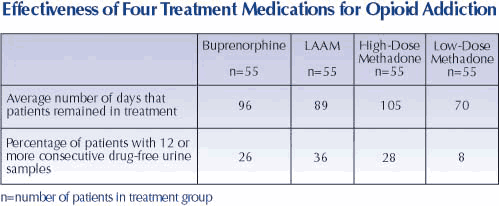NIDA-supported researchers continue to expand treatment options for heroin addicts. A recent clinical trial showed that buprenorphine can be as effective as levo-alpha-acetyl-methadol (LAAM) and high-dose methadone in the treatment of heroin addiction. All three of these medications are more effective than low-dose methadone.
Dr. Rolley Johnson of The Johns Hopkins University in Baltimore led the research team that compared the different types of opioid addiction treatment medications. The team randomly assigned 220 heroin-addicted volunteers between the ages of 21 and 55 to 1 of 4 treatments: 16 to 32 mg of buprenorphine 3 times a week; 75 to 115 mg of LAAM 3 times a week; high-dose (60 to 100 mg daily) methadone; or low-dose (20 mg daily) methadone.
 Buprenorphine proved as effective as LAAM and high-dose methadone in treating patients addicted to heroin. All three medications were more effective than low-dose methadone.
Buprenorphine proved as effective as LAAM and high-dose methadone in treating patients addicted to heroin. All three medications were more effective than low-dose methadone.Treatment effectiveness was measured through participants' reports of heroin use, medication and drug levels in participants' urine samples, and how long participants remained in the study. Participants in the buprenorphine, LAAM, and high-dose methadone groups who completed the study reported that their heroin use decreased 90 percent on average. Urine tests conducted 3 times a week revealed that LAAM produced the longest period of abstinence; 36 percent of these patients had 12 consecutive heroin-free urine samples. A total of 26 percent of buprenorphine and 28 percent of high-dose methadone patients, but only 8 percent of the low-dose methadone patients, had 12 consecutive negative tests. Overall, 50.9 percent of the study's participants completed the 17-week study. The retention rates ranged from a high of 72.7 percent in the high-dose methadone group to 58.2 percent in the buprenorphine group, 52.7 percent in the LAAM group, and 20 percent in the low-dose methadone group.
"This study illustrates that there is more than one alternative for the effective treatment of heroin addiction," says Dr. Frank Vocci, director of NIDA's Division of Treatment Research and Development. "Although methadone remains the 'gold standard,' the new medications do not have to be administered in public clinics and closely supervised in the way high-dose methadone administration has been in the past. The results of this research thus open the door to medical mainstreaming-treatment in doctors' offices and private facilities, rather than only in narcotic treatment programs-for individuals addicted to heroin."
"This research demonstrates that these three medications are effective for the treatment of heroin addiction and that a one-size-fits-all model is no longer necessary," says Dr. Johnson. "Future research will help clinicians identify which patients will benefit most from which medications.
"Heroin addiction is a chronic brain disease, and we can treat it like any other chronic medical condition-considering alternatives for treatment and planning that treatment based on individual patient needs," Dr. Johnson continues. "Since it is difficult to have this kind of medical model of treatment with only one medication, expanding the numbers and types of potential treatment medications should help bring the treatment of opiate addiction into mainstream medical practice."
Source
- Johnson, R.E., et al. A comparison of levomethadyl acetate, buprenorphine, and methadone for opioid dependence. New England Journal of Medicine 343(18):1290-1297, 2000. [Abstract]
